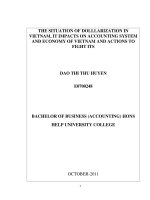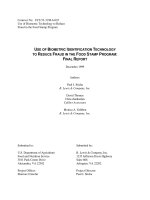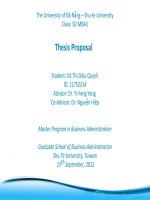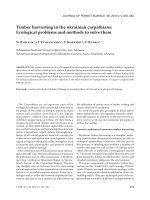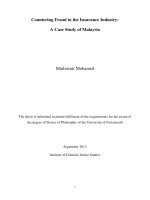Goldmann fraud in the markets; why it happens and how to fight it (2010)
Bạn đang xem bản rút gọn của tài liệu. Xem và tải ngay bản đầy đủ của tài liệu tại đây (1.59 MB, 273 trang )
Fraud in the Markets
Fraud in the Markets
Why It Happens and
How to Fight It
PETER GOLDMANN
John Wiley & Sons, Inc.
Copyright © 2010 by Peter Goldmann. All rights reserved.
Published by John Wiley & Sons, Inc., Hoboken, New Jersey.
Published simultaneously in Canada.
No part of this publication may be reproduced, stored in a retrieval system, or
transmitted in any form or by any means, electronic, mechanical, photocopying,
recording, scanning, or otherwise, except as permitted under Section 107 or 108
of the 1976 United States Copyright Act, without either the prior written
permission of the Publisher, or authorization through payment of the appropriate
per-copy fee to the Copyright Clearance Center, Inc., 222 Rosewood Drive,
Danvers, MA 01923, (978) 750-8400, fax (978) 646-8600, or on the web at
www.copyright.com. Requests to the Publisher for permission should be
addressed to the Permissions Department, John Wiley & Sons, Inc., 111 River
Street, Hoboken, NJ 07030, (201) 748-6011, fax (201) 748-6008, or online at
/>Limit of Liability/Disclaimer of Warranty: While the publisher and author have
used their best efforts in preparing this book, they make no representations or
warranties with respect to the accuracy or completeness of the contents of this
book and specifically disclaim any implied warranties of merchantability or
fitness for a particular purpose. No warranty may be created or extended by sales
representatives or written sales materials. The advice and strategies contained
herein may not be suitable for your situation. You should consult with a
professional where appropriate. Neither the publisher nor author shall be liable
for any loss of profit or any other commercial damages, including but not limited
to special, incidental, consequential, or other damages.
For general information on our other products and services or for technical
support, please contact our Customer Care Department within the United States at
(800) 762-2974, outside the United States at (317) 572-3993 or fax (317) 572-4002.
Wiley also publishes its books in a variety of electronic formats. Some content
that appears in print may not be available in electronic books. For more
information about Wiley products, visit our web site at www.wiley.com.
Library of Congress Cataloging-in-Publication Data:
Goldmann, Peter, 1953–
Fraud in the markets: why it happens and how to fight it/Peter Goldmann.
p. cm.
Includes index.
ISBN 978-0-470-50789-6 (cloth)
1. Capital market. 2. Corporations—Corrupt practices. I. Title.
HG4523.G65 2010
2009046298
364.16 3—dc22
Printed in the United States of America
10 9 8 7 6 5 4 3 2 1
To Barbara and Leah
Contents
Preface
xi
Acknowledgments
xv
INTRODUCTION A Brief History of Fraud
in Financial Markets
Banking Fraud in the Early Days
Market-Building by Morgan
Flim Flam Finance
Savings and Loan Fraud Follies
Beginning of the End
Off to the Races
CHAPTER 1
xvii
xvii
xxi
xxii
xxvi
xxvii
xxx
The Fraud Culture
I Wanna Be Rich
The Spread of Ethical Erosion
What It All Means
How We Got Here
The Evolving Shapes of Fraud
Pressure, Opportunity, and Rationalization
on Wall Street
A Triangle or a Diamond?
A Fraud Pentagon?
1
2
4
6
9
10
16
23
24
vii
Contents
CHAPTER 2
CHAPTER 3
The Politics of Banking Fraud
27
Politics and Regulation
Antebellum Banking
Early Due Diligence
Central Banking: The Drive Is Revived
Enter the ABA
The Warburg Factor
Financial Regulation Today
What If?
Is Regulation Here to Stay?
27
28
31
34
35
36
39
41
46
Modern Day Financial Services
Fraud (1980–2010)
51
The Fraud Culture and Today’s Frauds
The “Milken/Boesky” Era
Fancy Financing Foments More Fraud
The Ignominious Birth of “Pay
for Performance”
Risky. . .Riskier . . .
A Deluge of Derivatives
The Good Side of CDSs
Shortening Memories
Enron et al.
CHAPTER 4
CHAPTER 5
viii
Reform, Re-Regulation, and
the Persistence of Fraud
52
53
56
62
65
76
77
80
84
91
Better Antifraud Controls
Beyond Financial Reporting Fraud
Regulation and Legislation
More Aggressive Action Needed
92
95
110
111
The Real Estate Bubble and Bust:
The Fraud Factor
115
Contents
CHAPTER 6
CHAPTER 7
How Did It Get So Bad?
Subprime Mortgages: Licenses to Steal
Who Is Subprime?
Going for Broke(r)
117
123
125
130
The Makings of a Meltdown
137
Other Fraud-for-Profit Schemes
Greed Grows and Fraud Follows
Fraud-for-Property Schemes
The Role (or Not) of Predatory Lending
141
142
146
147
Beginning of the End: Death
by Derivatives
161
Playing with Fire
162
Chaos out of Order
164
Anatomy of a Subprime Deal
168
The Fine Art of Business Deception
171
Bankers Go with the Flow—Into the Tank 172
Hard Money
183
And Then There is AIG
190
How “Toxic” Securities Ended Up in
So Many Investor Portfolios
195
Rating Agency Deception Redux
198
And So, The End Begins
201
CHAPTER 8
Can the Circle Be Broken?
205
So What Now?
Critical Reform Issues
Policing, Policy, and Propriety
207
208
220
About the Author
223
Index
225
ix
Preface
All men are frauds. The only difference between them is
that some admit it. I myself deny it.
—H. L. Mencken
his book will examine a wide range of often complex factors
that played key roles in bringing the U.S. financial system
to the brink of collapse in 2007 and 2008.
Inevitably, the discussion will often have at its core or within
its subtext issues related to the subprime mortgage issue.
The reason for this is paradoxically simple: Had there been
no subprime mortgage industry—which didn’t even get its start
until the mid-1980s—there is a good chance that there would
have been no financial and economic meltdown.
Some would argue that this is an oversimplified view of the
meltdown. They would suggest that because of the culture of
greed, hubris, and invincibility on Wall Street, together with a
conspicuous absence of government and industry oversight, the
rise of the subprime “industry” was inevitable. They would further point out that the subprime problem proved to be only
one of many financial factors that collectively brought about
the worst crisis since the 1930s.
All true. Unfortunately, it is impossible to quantify the exact
degree to which each contributing factor catalyzed the financial
markets’ precipitous demise.
T
xi
Preface
In the end, what really matters is the subprime crisis’s related
financial failures and how the perfect storm that brought the
entire U.S. financial system to its knees came together. Thus,
this book will address such issues as:
■
■
■
■
■
The history of the financial markets and the origins of the
cultures of greed, financial omnipotence, and hubris that
gave rise to a fatal redefinition of risk in the late 1990s and
early 2000s.
The related culture of “anything goes” on Wall Street which
fueled the innovation of super-high-risk asset-backed securities whose excessive use went either unaddressed or
underestimated to the devastating disadvantage of institutions that invested in them.
The egregiously fraudulent lending practices that engulfed
virtually the entire U.S. mortgage industry, leading to the
fatal deterioration of balance sheets and ultimate collapse
of major players such as Washington Mutual, Wachovia,
Countrywide, as well as untold thousands of unscrupulous
mortgage brokers, appraisers, and independent lenders.
The wildly irresponsible decisions on the part of Wall Street’s
top honchos that cost them their firms, their jobs and the
livelihoods of tens of thousands of their employees and
clients.
The widespread fraudulent marketing of asset-backed
securities, based on exaggerated or completely fictitious
representations of risk levels, including the stunning indictments of two highly regarded Bear Stearns traders.
The latter part of the book will address options for preventing similar disasters from recurring and will provide readers with
practical guidelines for protecting themselves and their companies from various forms of fraud that were found to have played
a role in the current economic and financial crisis.
xii
Preface
Let it be noted at the outset that American economic
and financial history is blemished with numerous catastrophic
events, the most devastating of which was, of course, the Great
Depression. The history lesson that needs to be kept in mind
however, is that as much as our political leaders may try, they
will never be able to safeguard America’s financial institutions
from future crises. It can only be hoped that with a thorough
understanding of the factors and forces that triggered the crisis
of 2007–2008, there is at least a chance that those who lead our
nation will have the wisdom and foresight to render these future
events far less painful than those the country endured beginning
in the summer of 2007.
A note on terminology: Unlike the Great Depression, the
financial crisis that is the subject of this book has not as yet
been blessed with a colloquial household name. In the interest
of simplicity and consistency, the crisis will generally be referred
to in these pages as “the financial crisis of 2007–2008” or “the
meltdown of 2007–2008” (the two years during which most of
the damage and panic occurred).
xiii
Acknowledgments
any of the people who offered valuable insight and perspective on key topics in this book insisted on anonymity
in exchange for doing so. As part of the deal, they also required
exclusion from this segment of the book. However, they know
who they are and for their assistance I am indeed sincerely
appreciative.
Thomas Scanlon, CPA, CFP, a seasoned accountant at
Connecticut-based Borgida & Company, provided essential feedback throughout the book.
Stephen Pedneault, CFE, CPA, another Connecticut CPA and
a razor-sharp antifraud expert, also helped by sharing his experiences and detailed knowledge of key types of fraud that played
direct or indirect roles in the period leading up to the Great
Crash.
Chris Doxey of Business Strategy, Inc. in Grand Rapids,
Michigan was a great sounding board for many of the ideas that
went into putting this book together. Chris has a unique view of
the world of corporate crime, having been directly involved in
developing antifraud controls at companies after they fell victim
to financial trickery similar to that which came into play leading
up to the 2007–2008 crisis.
Thanks also to Tim Burgard of John Wiley & Sons, along
with his team of editors, whose efforts in forcing adherence
to tight deadline schedules ensured that this volume appeared
much earlier than it otherwise might have.
M
xv
INTRODUCTION
A Brief History of Fraud
in Financial Markets
he subprime mania that swept the home mortgage and securities markets, starting around 2002–2003, was the last straw
for the U.S. financial system as we knew it since the early years
of the twentieth century. Since the establishment of central banking in 1913, the American economy has toughed out several
recessions. But never before 2007—including the devastating
years of the Great Depression—has the economy and financial
system come as close to utter obliteration.
It is no coincidence though that the financial services industry was the breeding ground for the deadly forces that brought
on the Great Crash of 2008 and its aftershocks.
It is also no surprise that fraud played a starring role in the
emergence of these dark chapters in American financial history.
But it is important to understand the dynamics of earlier economic and financial crises in order to fully appreciate the genesis
of the 2008–2009 meltdown and the key role that criminal activity played in it.
T
Banking Fraud in the Early Days
Before the Civil War, the United States had a banking and financial system that could be described as “sketchy” at best. Prior to
xvii
Introduction
the advent of the railroad, barons like Jay Gould and Cornelius
Vanderbilt who exploited the underdeveloped and woefully misregulated businesses of borrowing and lending, made several
failed attempts to create a central bank.
One of the federal government’s efforts to establish a
national bank resulted in what is believed to be the largest
management-level bank fraud in post-Revolutionary history.
The target bank was the Second Bank of the United States
(SBUS), an institution that was two years in the making thanks
to intractable political divisiveness between supporters of state
banking and those who favored national banking. When the
SBUS was finally opened in early 1816, there were 19 branches,
of which the Baltimore and Philadelphia branches were among
the largest. Another nine were opened between 1817 and 1830.
The heads of these branches, along with other directors and
executives, exploited the country’s new frenzy over bank stocks
and proceeded to purchase controlling shares in the SBUS. They
used their power to establish their own financial firm whose sole
mandate apparently was to manipulate SBUS stock. Specifically,
one ploy used to drive up the price of SBUS shares was to pledge
their previously purchased SBUS shares as collateral for loans
from the SBUS in order to buy more of the bank’s own shares.
Though such unscrupulous activity would today be viewed as
the worst possible form of insider trading, it went unpunished
for several years within the SBUS. Worse, the bank executives
cooked the bank’s books to conceal these internal sham loans.
But the scheme went unnoticed due to a “see-no-evil” mindset among the bank’s directors that sounds disturbingly similar
to the mindset of the top bosses at Countrywide, Washington
Mutual, and other major players in the subprime lending business of the early 2000s who chose to turn a blind eye to the
rampant mortgage fraud that was making them mountains of
money. (More on this in Chapter 5.)
xviii
Introduction
Ultimately the SBUS conspirators were caught, but, curiously
enough, a Congressional investigation into the fraud resulted in
no recommendations for punitive action against the perpetrators, despite the findings of blatant violations of bank operating
rules and laws.1
Following the failure of the SBUS, Washington made further
efforts to stabilize the economy and monetary system. It did so
by issuing currencies of numerous varieties from gold and silver coins to demand notes to United States Notes affectionately
dubbed “greenbacks.” Federal efforts to bring stability to the
monetary system continued to be undermined by the cycle of
issuance and retraction of state-issued currencies that continued
over the decades leading up to the Civil War.
These were the products of “free banking” which is best
described as minimally regulated state banking in which anyone
could open a bank with next to no capital and issue its own
banknotes (currency) as loans to customers. Unfortunately for
most holders of these notes, the limited geographical usefulness
of the currency inevitably resulted in drastic depreciation and
ultimate losses.
While these monetary systems were loosely regulated by
state governments and as such were not fraudulent in and of
themselves, they did enable bank owners to exploit the system to illegal ends. They would purchase goods with the notes
immediately after issuance and get out of Dodge. Due to inadequate backing by shareholder equity, the notes would quickly
become worthless, the bank would fail, and the note holders
would be left with nothing.2
On a more brazenly fraudulent level, free banking gave rise
to what was aptly called wildcat banking. It took hold in numerous states, initially in Michigan and then in New York and several
other states. According to one top economic historian, this is
how it worked:
xix
Introduction
If the bond security [of the bank] was valued at more than
its market value, individuals had an incentive to buy bonds,
issue notes, and abscond with the proceeds.
For example, if someone could buy $80,000 worth of
bonds at current market prices and the bonds were valued as
security at their face value of, say, $100,000, and the notes
could be passed for more than $80,000, say $90,000, there is
a one-time gain of $10,000 in starting the bank. If the owner
could avoid being sued for noteholders’ losses, for example
by leaving the court’s jurisdiction, this difference between
the amount received for the notes and the market value of
the bonds created an incentive to start a bank and let it fail
quickly.3
Along with wildcat banking came rampant counterfeiting
and other swindles. Fortunately for the average American, the
free banking system was shut down by the federal government
through a levying of debilitating taxes. The banking industry
then became a federally-run system, with a whole new set of
flaws and regulatory loopholes.
This ongoing state of financial dysfunction brought with it
some relatively complex financial frauds, highlighted in 1867
by the landmark collapse of Credit Mobilier, a construction
company-turned-financial institution indirectly owned by the
financial promoters of the Union Pacific Railroad, which was
itself controlled by the federal government at the time.
The bank, originally organized by the aptly named George
Francis Train, existed for the prime purpose of financing the
railroad’s construction in exchange for ample “returns” generated by drawing down substantial loans that the government
had earlier provided to the railroad. But shortly after Congressman Oake Ames took over the “bank,” it was learned that Ames
had generously spread Credit Mobilier shares among numerous
Congressional colleagues to secure votes on additional federal
xx
Introduction
funding that was purportedly needed to complete the railroad’s
construction. The first major incident of pre-nineteenth century
financial fraud made the history books when the loan’s proceeds, to the tune of $23 million, ended up in the Credit Mobilier
owners’ pockets.
The subsequent collapse of Credit Mobilier thus also earned
the dubious distinction as the first major American financial
institution failure. The event shed light on America’s woefully
underdeveloped financial and regulatory structure.
Paradoxically, this period—the latter half of the nineteenth
century, which Mark Twain dubbed “The Gilded Age” in an 1873
eponymous novel he co-authored with Charles Warner—was a
time of unprecedented industrial advancement and rapid population growth. It was the period during which the oil empire of
John D. Rockefeller was built; when Andrew Carnegie joined the
elite ranks of the super-rich by master-crafting the largest steel
company in America; and when modern industrial infrastructure
including railroads, steel, and utilities took root.
Market-Building by Morgan
During this period, in 1892–1893, the first “real” stock market
crash occurred, as well as the era of the “Money Trust” of the
early 1890s—a term that came to be synonymous with John
Pierpont Morgan.4
Through the turn of the century and into the 1920s, Morgan built his father Junius’s London-based business partnership
with American banker extraordinaire, George Peabody into
the United States’ first major investment banking firm. During
those years, Morgan managed to earn a reputation of what former banking executive and financial historian, Charles Morris
defined as “absolute integrity and straight dealing.”5
Morgan was the builder of modern securities markets,
replacing the one-stop pseudo-monopolistic financing approach
xxi
Introduction
of Jay Gould. Under Morgan, shareholders actually became living, breathing investors to be respected and reckoned with.
He accomplished this by recapitalizing the railroads with
fresh cash, much of it originating in Europe where, in part thanks
to his father’s accomplishments, Morgan commanded enormous
admiration and respect. He simplified the capital structure of the
railroads into no more than two layers of debt with interest rates
that the railroads’ cash flows could comfortably manage. Equity
meanwhile was sold to a broad market of investors.
And then came The Great War, which sparked a massive
appetite for credit on the part of the Allies. Almost overnight
the dollar became the “modernized” world’s leading currency.
To raise funds for their war efforts, France and Britain turned
to JP Morgan for help. In what was at the time the largest bond
issuance ever, the Morgan dynasty orchestrated a $500 million
debt offer, cleverly selling them as “trade finance” bonds instead
of what they really were—“war bonds.”6
By the time the United States entered the war—in
1917—demand for U.S.-issued bonds was so great that the U.S.
Treasury was able to successfully market some $17 billion of its
own debt in the final year or so of the war.
By war’s end, so many “average” Americans had bought government debt that demand for consumer investment services
was more than adequate to fuel the rapid emergence of the
country’s retail securities industry.
Flim Flam Finance
Unsurprisingly, with the rapid growth of Western capitalism
in the late-nineteenth and early-twentieth centuries came great
temptation for employees and outsiders to steal from the country’s rapidly increasing number of banks and investment houses.
But in the end it was naive individual would-be investors who
xxii
Introduction
suffered most at the hands of swindlers peddling bogus securities to a public delirious with visions of overnight riches.
Things got progressively more precarious throughout the
“Roaring 1920s” which saw the frenzy over government debt
spread to equities and residential real estate. And while only
about two million Americans actually owned stock by the time
the market crashed in October 1929, the spread of securities
holdings among American investors was substantial enough to
give rise to a greatly exaggerated appreciation of the impact of
the market dive than was actually justified. In fact, as many historians have written, the market crash was not the cause of the
Great Depression. Rather, it was a by-product of misguided monetary policy and colossally misconceived foreign trade policy in
the form of the Smoot-Hawley Act of 1930 which effectively
choked off imports through astronomical tariffs, thus triggering
inflation and sluggish economic growth in Europe which had
been the source of large amounts of needed investment capital
in the fast-growing U.S. manufacturing base.
It is nonetheless undeniable that the spirit of speculation that
gripped the U.S. stock market beginning in the mid-1920s had
“imminent disaster” written all over it. And, not entirely unlike
the events of 2007–2008, fraud played a major role in bringing on
the inevitable bursting of the bubble. Huge amounts of bogus
stock were sold to investors, rich and poor, while legitimate
issues of equities experienced stupendous price growth within
very short periods of time.
One of the more colorful examples of this financial chaos
is the story of Ivar Kreuger, a Swedish entrepreneur who built
his father’s tiny match manufacturing business into the world’s
dominant supplier of “safety matches.”
Kreuger arrived in the United States in 1922 having realized that the poverty of many European governments after
World War I provided an opportunity for capitalists with cash. He
xxiii

